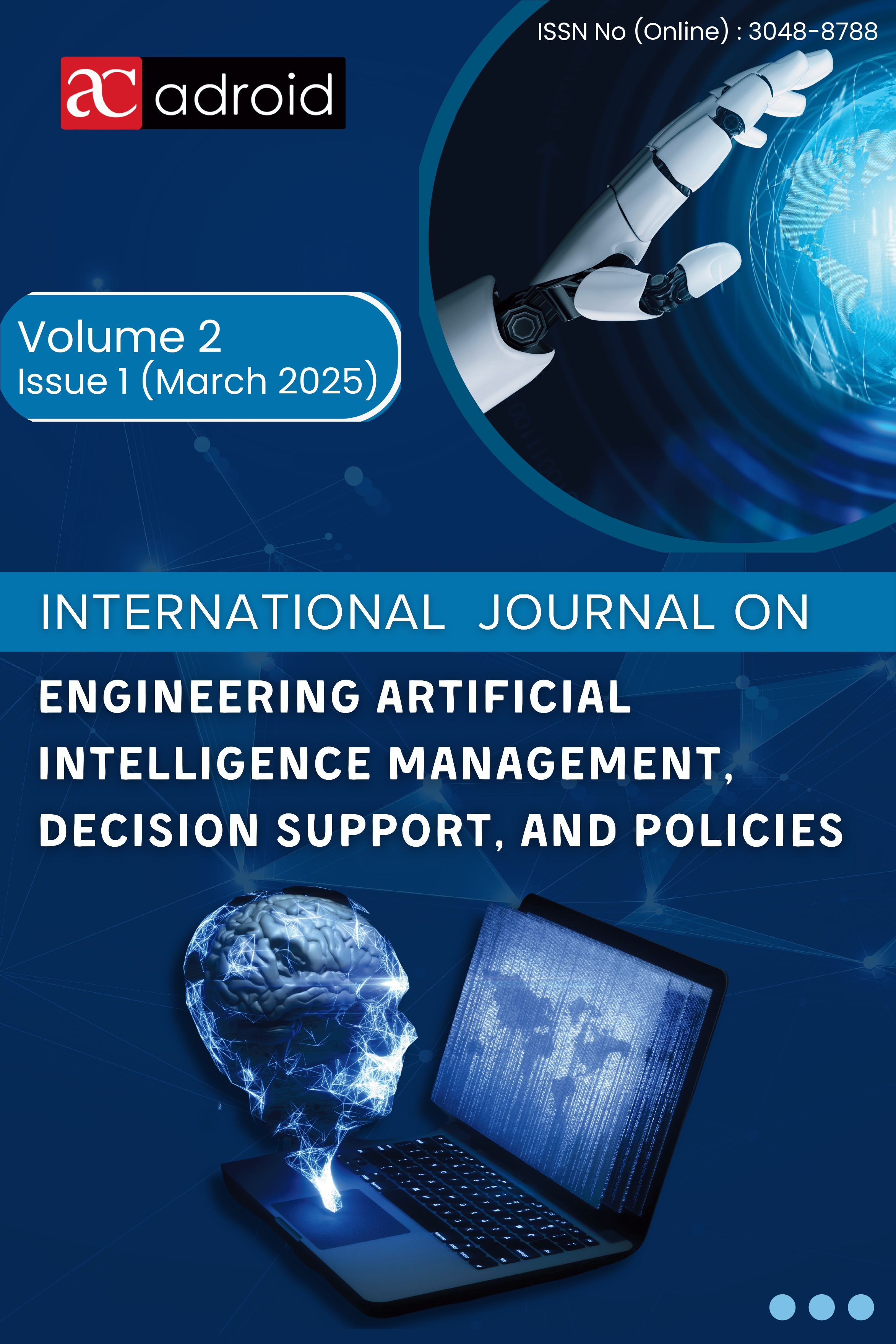AI-Driven Cybersecurity Measures for Hybrid Cloud Environments: A Framework for Multi-Cloud Security Management
DOI:
https://doi.org/10.63503/j.ijaimd.2025.39Keywords:
Artificial Intelligence, Multi-Cloud Security, Threat Assessment, Hybrid Cloud, Autonomous Security, Cybersecurity, Quantum Computing, Real-Time Threat Response, Adaptive Security SystemsAbstract
The complex landscape of multi-cloud settings is the result of the fast growth of cloud computing and the ever-changing needs of contemporary organizations. Strong cyber defenses are of fundamental importance in this setting. In this study, we investigate the use of AI in hybrid cloud settings for the purpose of multi-cloud security management. For hybrid cloud deployment, this mathematical approach maximizes a security metric. Programmers use backslashes to escape special char acters and identify file paths. The objective function optimizes application and data asset security by using AI-enhanced security solutions across all cloud providers, taking their weights into consideration. The conclusion is that hybrid cloud environ ments can benefit greatly from AI-enabled multi-cloud security management. Us ing a combination of mathematical modeling and data-driven AI techniques, we were able to dynamically adjust our security allocations in real-time response to evolving threats, optimize effective resourcing for threat incident response based on continuous risk assessment/prediction, learning from past incidents as well as feedforward modeling. Although the paper studies hypothetical data, it provides a nicely conceptual basis for using empirical data in the real world and this study is an important step towards navigating practical implications in cloud security man agement a sentence.
References
[1]. R. Vargas‐Bernal, “Emerging Trends and Future Directions in Artificial Intelligence for Next‐Generation Computing, ” Computational Intelligence for Autonomous Finance, pp. 289– 312, Nov. 2024, doi: 10.1002/9781394233250.ch14.
[2]. D. Milojicic, P. Faraboschi, N. Dube, and D. Roweth, “Future of HPC: Diversifying Heterogeneity,” 2021 Design, Automation & Test in Europe Conference & Exhibition (DATE), pp. 276–281, Feb. 2021, doi: 10.23919/date51398.2021.9474063.
[3]. M. Saleem Sultan and M. Shahid Sultan, “Leveraging Artificial Intelligence for Enhanced Cybersecurity: A Systematic Approach,” International Journal of Science and Research (IJSR), vol. 13, no. 8, pp. 832–839, Aug. 2024, doi: 10.21275/sr24812100704.
[4]. S. B. G. T. Babu and C. S. Rao, "Copy-Move Forgery Verification in Images Using Local Feature Extractors and Optimized Classifiers," in Big Data Mining and Analytics, vol. 6, no. 3, pp. 347-360, September 2023, doi: 10.26599/BDMA.2022.9020029.
[5]. I. A. Kandhro et al., “Detection of Real-Time Malicious Intrusions and Attacks in IoT Empowered Cybersecurity Infrastructures,” IEEE Access, vol. 11, pp. 9136–9148, 2023, doi: 10.1109/access.2023.3238664.
[6]. N. Moustafa, N. Koroniotis, M. Keshk, A. Y. Zomaya, and Z. Tari, “Explainable Intrusion Detection for Cyber Defences in the Internet of Things: Opportunities and Solutions,” IEEE Communications Surveys & Tutorials, vol. 25, no. 3, pp. 1775–1807, 2023, doi: 10.1109/comst.2023.3280465.
[7]. O. Alkadi, N. Moustafa, and B. Turnbull, “A Review of Intrusion Detection and Blockchain Applications in the Cloud: Approaches, Challenges and Solutions,” IEEE Access, vol. 8, pp. 104893–104917, 2020, doi: 10.1109/access.2020.2999715.
[8]. D. Patil, “Artificial Intelligence In Cybersecurity: Enhancing Threat Detection And Prevention Mechanisms Through Machine Learning And Data Analytics,” 2025, doi: 10.2139/ssrn.5057410.
[9]. Md. M. Rashid et al., “Adversarial training for deep learning-based cyberattack detection in IoT-based smart city applications,” Computers & Security, vol. 120, p. 102783, Sep. 2022, doi: 10.1016/j.cose.2022.102783.
[10]. J. D. Herath, P. Yang, and G. Yan, “Real-Time Evasion Attacks against Deep Learning-Based Anomaly Detection from Distributed System Logs,” Proceedings of the Eleventh ACM Conference on Data and Application Security and Privacy, Apr. 2021, doi: 10.1145/3422337.3447833.[11]. P. Das and S. Saif, “Intrusion Detection in IoT-Based Healthcare Using ML and DL Approaches: A Case Study,” Artificial Intelligence and Cyber Security in Industry 4.0, pp. 271–294, 2023, doi: 10.1007/978-981-99-2115-7_12.
[12]. G. Kocher and G. Kumar, “Machine learning and deep learning methods for intrusion detection systems: recent developments and challenges,” Soft Computing, vol. 25, no. 15, pp. 9731–9763, Jun. 2021, doi: 10.1007/s00500-02105893-0.
[13]. A. Reddy H Shivamurthy, “Predicting the Energy Efficiency in Wireless Sensor Networks using LSTM and Random Forest Method,” International Journal of Science and Research (IJSR), vol. 13, no. 1, pp. 805–811, Jan. 2024, doi: 10.21275/sr24105145623.
[14]. M. A. Al-Shareeda, S. Manickam, and M. A. Saare, “DDoS attacks detection using machine learning and deep learning techniques: analysis and comparison,” Bulletin of Electrical Engineering and Informatics, vol. 12, no. 2, pp. 930–939, Apr. 2023, doi: 10.11591/eei.v12i2.4466.
[15]. B. Bala and S. Behal, “AI techniques for IoT-based DDoS attack detection: Taxonomies, comprehensive review and research challenges,” Computer Science Review, vol. 52, p. 100631, May 2024, doi: 10.1016/j.cosrev.2024.100631.
[16]. N. Ahmed et al., “Network Threat Detection Using Machine/Deep Learning in SDN-Based Platforms: A Comprehensive Analysis of State-of-the-Art Solutions, Discussion, Challenges, and Future Research Direction,” Sensors, vol. 22, no. 20, p. 7896, Oct. 2022, doi: 10.3390/s22207896.
[17]. H. Maryam, S. Z. N. Zukhraf, and R. Ullah, “Comparative Analysis of Machine and Deep Learning for Cyber Security,” Cyber Security for Next-Generation Computing Technologies, pp. 39–69, Nov. 2023, doi: 10.1201/9781003404361-3.
[18]. R. Yang, D. Qu, Y. Gao, Y. Qian, and Y. Tang, “nLSALog: An Anomaly Detection Framework for Log Sequence in Security Management,” IEEE Access, vol. 7, pp. 181152–181164, 2019, doi: 10.1109/access.2019.2953981.
[19]. M. Landauer, F. Skopik, M. Wurzenberger, and A. Rauber, “System log clustering approaches for cyber security applications: A survey,” Computers & Security, vol. 92, p. 101739, May 2020, doi: 10.1016/j.cose.2020.101739.
[20]. B. Lindemann, B. Maschler, N. Sahlab, and M. Weyrich, “A survey on anomaly detection for technical systems using LSTM networks,” Computers in Industry, vol. 131, p. 103498, Oct. 2021, doi: 10.1016/j.compind.2021.103498.
[21]. A. Sahu et al., “Federated LSTM Model for Enhanced Anomaly Detection in Cyber Security: A Novel Approach for Distributed Threat,” International Journal of Advanced Computer Science and Applications, vol. 15, no. 6, 2024, doi: 10.14569/ijacsa.2024.01506125

